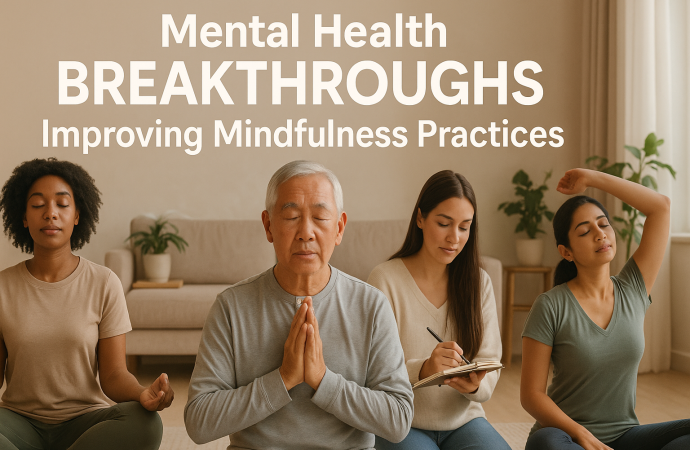Introduction In recent years, interest in mindfulness practices has skyrocketed. People seek tools to manage stress, boost focus, and improve overall well-being. At the same time, mental health breakthroughs are reshaping how we approach self-care. New therapies and technologies are making it easier than ever to improve mindfulness and deepen the mind-body connection. This article
Introduction
In recent years, interest in mindfulness practices has skyrocketed. People seek tools to manage stress, boost focus, and improve overall well-being. At the same time, mental health breakthroughs are reshaping how we approach self-care. New therapies and technologies are making it easier than ever to improve mindfulness and deepen the mind-body connection.
This article explores the key 2025 mindfulness innovations and mental health breakthroughs that are transforming how we practice mindfulness exercises. From cutting-edge brain‑computer interfaces to wide range AI‑guided meditation and immersive virtual reality, we’ll cover the tools and methods that help you stay present, reduce anxiety, quality of life and enhance mental resilience. Whether you’re a beginner or a seasoned meditator, these insights will help you thrive.
What Are Mindfulness Practices?

Image by: Yandex.com
Mindfulness practices are activities that bring your attention to the present moment. They help you observe your thoughts, feelings, and sensations without judgment. Common practices include:
- Deep breathing
- Body scans
- Guided meditation
Consistent practice can reduce stress, improve sleep, and boost focus. As science catches up, researchers find that mindfulness changes brain structure in areas tied to attention and emotion regulation. This reveals how powerful simple exercises can be.
By 2025, we expect mindfulness to be integrated into schools, workplaces, and healthcare. New meditation trends will offer fresh ways to feel good, stay mindful, even on busy days. The goal is clear: make it easy to pause, breathe, and reconnect with yourself.
What Do Mental Health Breakthroughs Bring?

Image by: Yandex.com
Mental health breakthroughs refer to new treatments, tools, and research that advance our understanding of the brain and behavior. Recent breakthroughs include:
- Neurofeedback training
- AI‑driven therapy apps
- Virtual reality exposure therapy
Each breakthrough opens a door for mindfulness practices. For example, AI can guide you through personalized meditation designs. VR can place you in calming, simulated environments. Neurofeedback offers real‑time data on brain waves, so you can see how meditation changes your mind.
These innovations make mindfulness more precise and engaging. They also help people with conditions like anxiety, depression, and ADHD find relief. As we move into 2025, the blend of technology and therapy promises deeper, faster results.
Top Mental Health Breakthroughs Improving Mindfulness

Image by: Yandex.com
1. Neurofeedback Enhance Mindfulness
Neurofeedback is a type of wellness technology that uses sensors to measure brain activity. When you meditate, a neurofeedback device shows your brain waves in real time. The goal is to train your brain to enter calm, focused states more easily.
During a session, you might wear a headset that tracks your alpha and theta waves. A screen or headset then rewards you with visuals or sounds when your brain reaches a desired state. Over time, your brain learns to maintain that state without the device.
Neurofeedback can help with:
- Reducing anxiety
- Improving attention
- Deepening meditation
By seeing instant feedback, you can adjust your practice on the fly. This makes mindfulness practices more effective and personalized.
2. Guided Meditation Apps
Thanks to guided meditation apps, anyone can access expert‑led sessions on their phone. These apps use AI to tailor sessions based on your mood, goals, and schedule. Features include:
- Daily reminders
- Mood check‑ins
- Progress tracking
Popular apps now offer thousands of guided sessions, ranging from two‑minute “micro‑breaks” to hour‑long retreats. They also include ambient soundscapes and breathing exercises that match your stress level.
Tip: Try mood‑adaptive sessions that use short surveys to recommend the right meditation style. This keeps your practice fresh and effective, even when you’re short on time.
3. Wearable Biofeedback
Wearable biofeedback devices measure physical signals like heart rate variability (HRV), skin temperature, and muscle tension. When paired with mindfulness practices, they offer a window into your body’s stress response.
Imagine wearing a smartwatch that vibrates gently when your HRV drops, signaling stress. You then pause to practice deep breathing or a quick body scan. Over days and weeks, you learn to spot stress before it rises.
Common devices include:
- Smart rings that track sleep and HRV
- Wristbands with guided breathing lights
- Chest straps for posture and breathing feedback
These tools make mindfulness a constant companion. They help you build awareness of stress triggers and support lasting change.
4. Virtual Reality Mindfulness
Virtual reality mindfulness places you in immersive 3D environments. You might find yourself on a serene beach, in a peaceful forest, or floating among the clouds. VR apps guide you through meditation while visuals and audio deepen the experience.
Benefits include:
- Reducing sensory distractions
- Enhancing emotional engagement
- Offering safe exposure therapy for phobias
VR can also simulate social support, placing you in guided group meditations with avatars. This blends social connection with inner calm, a powerful aid for those who feel isolated in their practice.
Tip: Choose VR sessions that focus on grounding exercises. They anchor you in your body even as your senses explore another world.
5. Teletherapy Integrate Mindfulness
Teletherapy brings licensed therapists to your screen. In 2025, many therapists will blend mindfulness into online sessions. They guide you through:
- Mindful breathing during stress
- Body scans for tension relief
- Acceptance exercises for mental health
Teletherapy can adapt practices to your daily life. A therapist might record a custom breathing exercise you can replay when anxiety strikes. This personalized approach deepens your practice and makes mindfulness practices more relevant.
Combined with self‑guided tools, teletherapy offers a hybrid path—professional support plus daily practice. This model grows in popularity as mental health care pursues both efficiency and empathy.
6. Wellness Technology Trends to Watch
Beyond the tools above, several wellness technology trends are on the horizon:
- Adaptive soundscapes that shift with your mood
- AI coaches that guide micro‑mindfulness breaks
- Smart home integration for meditation lighting and aroma
These trends aim to weave mindfulness into every part of life. Imagine lights dimming automatically when you start breathing exercises, or your coffee maker waiting until after your morning meditation.
The future of mindfulness practices is about seamless support. Technology will know when you need a break, offering gentle nudges and custom sessions before stress builds.
The Future of Mindfulness and Mental Health

Image by: Yandex.com
The next wave of breakthroughs promises to blend ease and science even further. Artificial‑intelligence coaches will adjust sessions to match a person’s mood in real time, offering gentle nudges like “Take a walk” or “Call a friend.” Cheaper sensors could bring biofeedback rings and patches to neighborhood pharmacies, helping users track stress without bulky gear. Public health programs may add free mindfulness lessons to cut costs tied to stress‑related illnesses. Research into sounds, light patterns, and micro‑meditation could unlock even faster ways to calm the mind. With these advances, caring for mental health should feel simpler, quicker, and more natural for people everywhere.
Comparison Table: Key Breakthroughs
| Breakthrough | How It Works | Benefit |
|---|---|---|
| Neurofeedback | Real‑time brain wave feedback via sensors | Faster, data‑driven mindfulness training |
| Guided Meditation Apps | AI‑personalized sessions on smartphones | Ease of access, tailored meditation plans |
| Wearable Biofeedback | Tracks HRV, temperature, tension | Immediate stress alerts, habit building |
| Virtual Reality Mindfulness | Immersive 3D environments for guided meditation | Deeper emotional engagement, fewer distractions |
| Teletherapy Integration | Licensed therapists guide mindfulness online | Personalized, empathic support |
| Adaptive Soundscapes | Dynamic audio that shifts with user feedback | Continuous calm throughout the day |
Conclusion
The landscape of mindfulness practices is evolving fast thanks to major mental health breakthroughs. Technologies like neurofeedback, guided meditation apps, and virtual reality mindfulness make it easier to find calm and focus. Wearable biofeedback and teletherapy ensure you have support whenever you need it. As we embrace these 2025 mindfulness innovations, we gain new paths to reduce stress, enhance mental well‑being, and strengthen the mind-body connection.
















